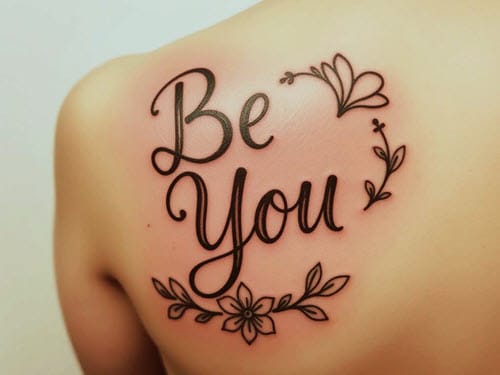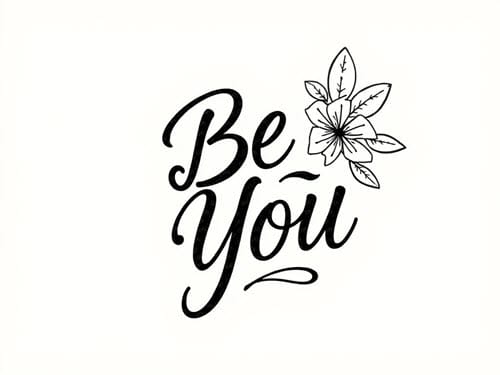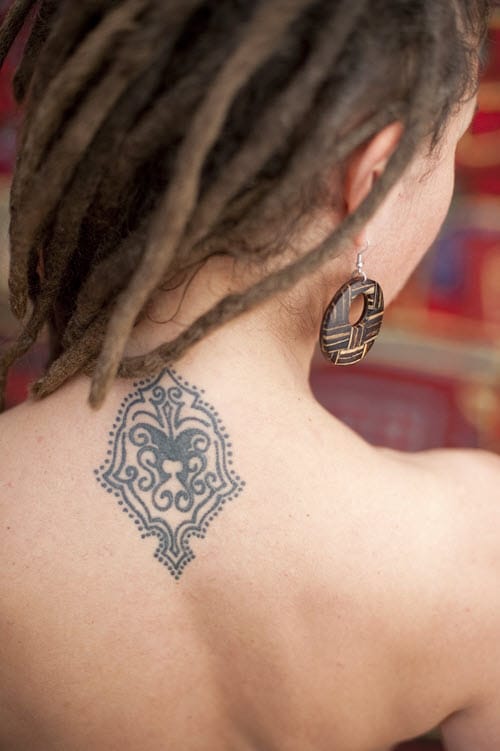I am thinking about getting a tattoo.
How should I start?
Here are some ideas:
1. Choose a tattoo design or image you want. You can create your original design or find a pre-existing image you like. Many tattoo shops also have pre-made designs from which you can select.
2. Find a reputable tattoo artist or studio—research reviews and portfolios to find an artist whose style and skill level match what you desire.
3. Make an appointment with the tattoo artist. You can discuss the design, placement, size, and any other preferences during the consultation. The artist may also provide feedback or suggestions.
4. Using a stencil or freehand, The artist will transfer the design or image onto your skin. They will use tattoo machines to inject the ink into the skin.
5. Depending on the size and complexity of the design, the tattooing process can take anywhere from 30 minutes to several hours, or even longer. A very large and complex design may require multiple sessions.
6. Proper aftercare is important to ensure the tattoo heals properly. The artist will provide guidance on cleaning, moisturizing, and protecting the new tattoo as it heals over the following weeks.
In Summary
You don’t necessarily have to draw your design—you can simply bring in an image you want tattooed. The artist can then transfer and modify the design as needed. The key is finding a skilled, reputable tattoo professional to work with.



How do I select a Tattoo Artist?
Finding the Right Artist
Research: Look for artists with good reviews, a strong portfolio, and a nice website. Social media platforms like Instagram can be great for this.
Styles: Artists often specialize in particular styles (e.g., flowers, traditional, realism, watercolor, tribal). Choose someone whose work resonates with your vision.
When you have narrowed down the list, it is vital to have a consultation. Remember, you must work with a great artist—you will have the tattoo for a long time.
Discuss Ideas: Share your design concept, preferred placement, and concerns.
Artist’s Input: A good artist will provide feedback on the design, suggesting adjustments for better aesthetics or longevity.
What are some things to keep in mind when researching a tattoo artist?
When researching a tattoo artist, consider the following factors:
Portfolio: Review the artist’s portfolio to see their previous work. Look for consistency in quality, style, and detail.
Specialization: Some artists specialize in particular styles (e.g., realism, traditional, watercolor). Choose one whose style aligns with your vision.
Hygiene and Safety: Ensure the studio follows strict hygiene practices. Check for cleanliness, equipment sterilization, and single-use needles.
Reviews and Reputation: Look for online reviews and testimonials. Positive feedback from previous clients can indicate a reliable artist.
Consultation: Schedule a consultation to discuss your idea. This allows you to gauge the artist’s communication skills and willingness to collaborate. Collaboration is essential to the experience and result.
Experience: Consider the artist’s experience level. More experienced artists may be better equipped to handle complex designs.
Comfort Level: Ensure you feel comfortable with the artist. A good rapport can make the process more enjoyable.
Pricing: Understand the pricing structure. Some artists charge by the hour, while others have flat rates for specific designs. Be clear about what’s included.
Aftercare Knowledge: A good artist should provide detailed aftercare instructions and even aftercare products to ensure proper healing.
Location: This may be a factor if multiple sessions are needed. The location should be easily accessible.
Researching and choosing the right tattoo artist can significantly impact your overall experience and satisfaction.
What About Tattoo Artist Referrals?
The best tattoo artists don’t have to advertise because their work speaks for them.
When you see someone with a great tattoo, ask them where they got it. This is a perfect approach if the tattoo you see on someone else is like the one you are considering.
Ask them who their tattoo artist is. Remember, when you’re looking for a great tattoo, you don’t simply walk into any tattoo shop and expect to get one. If you want the best tattoo, think about what you want and know who can deliver it.
Should I Get Multiple Quotes?
It is perfectly fine to receive quotes from multiple tattoo shops. Getting multiple quotes will give you a good idea of what your tattoo will cost but can help you gauge the quality of work you will receive as the quote is part of the process.
Note that cheap tattoos are a terrible idea.
A great tattoo artist is worth their weight in gold (your tattoo will be with you forever), and you want a tattoo artist who understands how your tattoo will adjust with your body through the years.
With tattoos, you get what you pay for, and though pricing is important to consider when choosing your tattoo shop, make sure you understand what a great tattoo should cost.
How Well Should I Know The Artist?
Getting to know the artist and having them take the time to get to know you is very valuable. Have a conversation with the artist. Listen carefully to how the tattoo artist answers your questions.
You want to know how they view the type of tattoo you are considering. It is OK to share a little about yourself with them. This will help you both be more comfortable when it comes time for you to get your tattoo.
You want to pick an artist best suited for your tattoo style. Letting the artist get to know you allows them to get a better idea of how to personalize your tattoo and really bring your vision to life.
Be You Tattoo wants to help you select the best tattoo for you and want to get to know you to serve you in the best possible way.
What Is One Way To Tell A Good Artist From A Bad One?
A bad artist will simply scribble their design onto your skin with little regard for clean lines or symmetry.
A good artist, on the other hand, will take their time to create a precise and beautifully executed design.
How Should I Judge The Quality Of A Tattoo?
The lines of a tattoo must be crisp, straight, and constant throughout the tattoo. Wonky lines are a significant indicator of an unskilled artist.
How Should I Care For My Tattoo In The Frist Two Weeks?
Sleeping:
The first thing to consider is your first couple of nights’ sleep. Many tattoo enthusiasts have a separate set of sheets for when they get tattooed. Many wake up in the morning to find a fresh imprinted stain of their tattoo on those expensive nice Egyptian sheets, that won’t come out.
It is important here to remind you that you shouldn’t re-bandage your tattoo. Your skin needs to breathe to promote and speed the healing process. So, if you get a tattoo on your back, you must sleep on your belly for a few days or vice versa.
If you can sleep with your tattoo exposed, that would be best. If not, you can place a clean, thin towel between you and the sheets. If in the morning your sheets are stuck to you, follow the same instructions as a stuck bandage: Don’t peel the sheet off; take the sheet with you to the shower and wet it off with cool or lukewarm water.
Do Not Pick At Your New Tattoo:
Your tattoo will look good over the first few days, and any redness should go away. Then, you will notice that it will start to look duller and can even form a little white haze. This typically happens to more extensive or solid color or tribal pieces. You may see some scabbing form as well. This is all normal.
However, heavy scabbing is not normal and needs to be watched closely. One of the most important things to remember is not picking at any scabbing.
Even if the scabbing is small, let it fall off over time and/or during the gentle cleaning. Picking can SCAR your skin and ruin the tattoo or, at the very least, cause light spots that will have to be touched up.
You will see the skin peel like a mild sunburn. This is normal. You may also experience some color coming off while putting on ointment or during the cleaning process; again, this is totally normal and nothing to be concerned about.
This whole scenario can last over the next 4 to 10 days.
You will then see the color coming back clean and clear, and your tattoo will be in the end stages of healing. By day 14, your new art piece should look fully healed. You will want to continue putting lotion or ointment on until there is no shine to the skin.
Clothing:
Clothing can be a significant factor in your healing process. Depending on where you get your tattoo, you must wear loose-fitting clothes. Ladies, you are the major offender of this problem. As noted above, your tattoo needs to breathe!
Tight-fitting clothes prevent this. Another issue is that if your tattoo is forming a light scab and you have some tight-fitting clothes rubbing on it, that can cause problems in the healing. It can cause scarring and light spots in the tattoo.
Bikini lines and bra strap areas are prime examples of this. Foot tattoos are another example, ladies. You will need to go shoeless for close to a week. Socks, shoes, and boots are breeding grounds for bacteria, and rubbing is also a big issue.
Your clothing can be a big help with issues at work or the sun. Remember you don’t want to re-bandage a tattoo, but if you are in a working environment that risks contact with harmful chemicals, a germ-filled situation, or just things coming in constant contact with your tattoo, loose-fitting clothes can be your best friend.
The Sun:
The sun is probably the single worst enemy and destroyer of tattoos. During the initial healing process, you absolutely need to keep your new tattoo out of the sun, as it will damage the skin further and can cause all sorts of problems, from scaring your tattoo to lightening it up and uneven healing.
This comes back to the early comments about clothing. If you have a job that keeps you outside, wear loose-fitting clothes to keep your tattoo out of the sun, and as a last resort, use a sterile, non-stick bandage. Do not use a tanning bed until your tattoo is fully healed.
You have just paid for a work of art. Let your tattoo fully heal before exposing it to the sun. If you must expose your new tattoo to the sun, get the strongest SPF sun block that you can find and keep it handy (a minimum of 50 SPF).

I look forward to meeting and working with you on your custom tattoo design.
You may contact me so that we can start the process of creating your custom tattoo.

